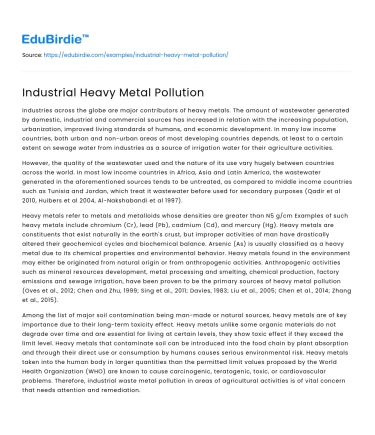Industries across the globe are major contributors of heavy metals. The amount of wastewater generated by domestic, industrial and commercial sources has increased in relation with the increasing population, urbanization, improved living standards of humans, and economic development. In many low income countries, both urban and non-urban areas of most developing countries depends, at least to a certain extent on sewage water from industries as a source of irrigation water for their agriculture activities.
However, the quality of the wastewater used and the nature of its use vary hugely between countries across the world. In most low income countries in Africa, Asia and Latin America, the wastewater generated in the aforementioned sources tends to be untreated, as compared to middle income countries such as Tunisia and Jordan, which treat it wastewater before used for secondary purposes (Qadir et al 2010, Huibers et al 2004, Al-Nakshabandi et al 1997).
Save your time!
We can take care of your essay
- Proper editing and formatting
- Free revision, title page, and bibliography
- Flexible prices and money-back guarantee
Heavy metals refer to metals and metalloids whose densities are greater than N5 g/cm Examples of such heavy metals include chromium (Cr), lead (Pb), cadmium (Cd), and mercury (Hg). Heavy metals are constituents that exist naturally in the earth's crust, but improper activities of man have drastically altered their geochemical cycles and biochemical balance. Arsenic (As) is usually classified as a heavy metal due to its chemical properties and environmental behavior. Heavy metals found in the environment may either be originated from natural origin or from anthropogenic activities. Anthropogenic activities such as mineral resources development, metal processing and smelting, chemical production, factory emissions and sewage irrigation, have been proven to be the primary sources of heavy metal pollution (Oves et al., 2012; Chen and Zhu, 1999; Sing et al., 2011; Davies, 1983; Liu et al., 2005; Chen et al., 2014; Zhang et al., 2015).
Among the list of major soil contamination being man-made or natural sources, heavy metals are of key importance due to their long-term toxicity effect. Heavy metals unlike some organic materials do not degrade over time and are essential for living at certain levels, they show toxic effect if they exceed the limit level. Heavy metals that contaminate soil can be introduced into the food chain by plant absorption and through their direct use or consumption by humans causes serious environmental risk. Heavy metals taken into the human body in larger quantities than the permitted limit values proposed by the World Health Organization (WHO) are known to cause carcinogenic, teratogenic, toxic, or cardiovascular problems. Therefore, industrial waste metal pollution in areas of agricultural activities is of vital concern that needs attention and remediation.(Yaylalı-Abanuz, 2011).






 Stuck on your essay?
Stuck on your essay?

